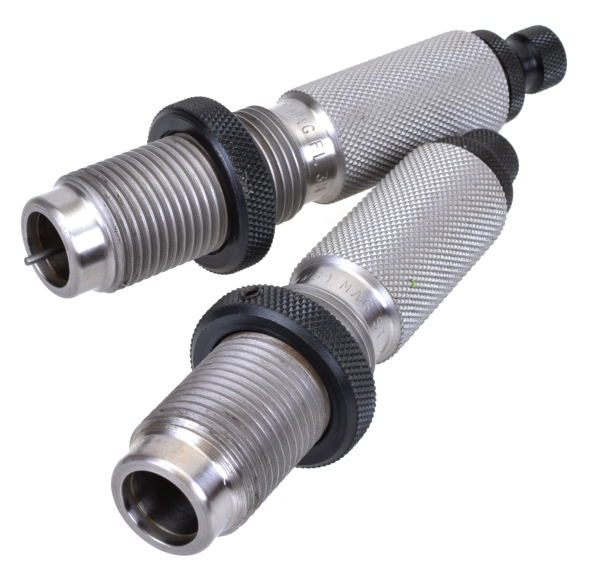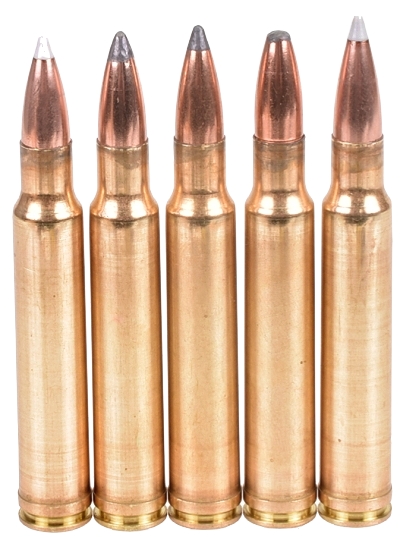I wasn’t sure if a Part II would be required for the Weatherby Mark V Sporter .340 Weatherby Magnum review. The rifle performed well and looked good in ways that made its $1,600 price tag seem a bargain. Still, there was an opportunity to try something other than factory ammo and to see how a broader range of bullet weights would perform. So… a brief Part II.

Probably a good place to begin, reloading dies. In the course of conducting projects we use just about every brand of die set and, for the most part, the selection isn’t critical within name brands. In the case of Weatherby cartridges, as high intensity belted magnums, Redding full length resizing are a brand preference. They provide better case support overall, and size close to the belt and to a tighter spec than most other die sets.

Bullets selected are representative of weights and ballistic coefficients available for 0.338″ cartridge. There are many, many more featuring various types of construction and tolerances for impact velocity. The pictured bullets appear on the data table below in left to right order, tabled from top to bottom.
For me, the .338″ magnum’s most useful bullet weight has been 250 grains. Nothing wrong with a 180 grain bullet that can handle the probable impact velocity, but it is a lot of smokeless powder to kill a deer or other medium size thin skin game. Likewise, there are some very tough 250 grain bullets that should do just about anything a 275 or 300 grain bullet could do to a big bear or moose and do it with a much flatter trajectory.
Assembly was straight forward, sizing was routine, brass held up well through a few reloading cycles without failures, although I would probably neck anneal before using them again. Primer pocket seating remained firm. I’ve recently read criticisms of Norma brass regarding their “loose primer pocket problem”. I’ve never experienced that problem and always found Norma brass to be a gold standard.

Warning: Bullet selections are specific, and loads are not valid with substitutions of different bullets of the same weight. Variations in bullet length will alter net case capacity, pressure and velocity. Primer selection is specific and primer types are not interchangeable. These are maximum loads in my firearms and may easily be excessive in others. All loads should be reduced by 5%, and developed following safe handloading practices as represented in established reloading manuals produced by component manufacturers. Presentation of these loads does not constitute a solicitation for their use, nor a recommendation.
|
|||||||||||||||||||||||||||||||||||||||||||||||||||||||||||||||||||||||||||||||||||||||||||||||||||||||||||||||||||||||||||||||||||||||||||||||||||||||||||||||||||||||||||||||||||||
|
|||||||||||||||||||||||||||||||||||||||||||||||||||||||||||||||||||||||||||||||||||||||||||||||||||||||||||||||||||||||||||||||||||||||||||||||||||||||||||||||||||||||||||||||||||||
It’s only a couple of hundred feet per second…
It is interesting that most handloading manuals uniformly and almost universally note that the .340 Weatherby Magnum holds only a 150 to 200 fps edge over the .338 Winchester Magnum. I’m guessing the authors collectively forgot the laws of physics and energy increasing at the square of the velocity. In this case, the .340 Weatherby has a near 500 ft/lbs of kinetic energy edge at 300 yards and a 22 yard point blank advantage.

In may ways the .340 Weatherby is a more well balanced rifle than the more powerful .338-378 Weatherby; lighter rifle, more efficient cartridge, less recoil, exceptionally accurate. No, not a rifle for whitetail deer and coyotes, but elk and bear, Alaskan Moose… anywhere a .338 Winchester would be a good choice, the Weatherby Mark V .340 Weatherby would be even better.
Weatherby’s Mark V Sporter Part I
Weatherby’s Mark V Sporter Part 2

Email Notification